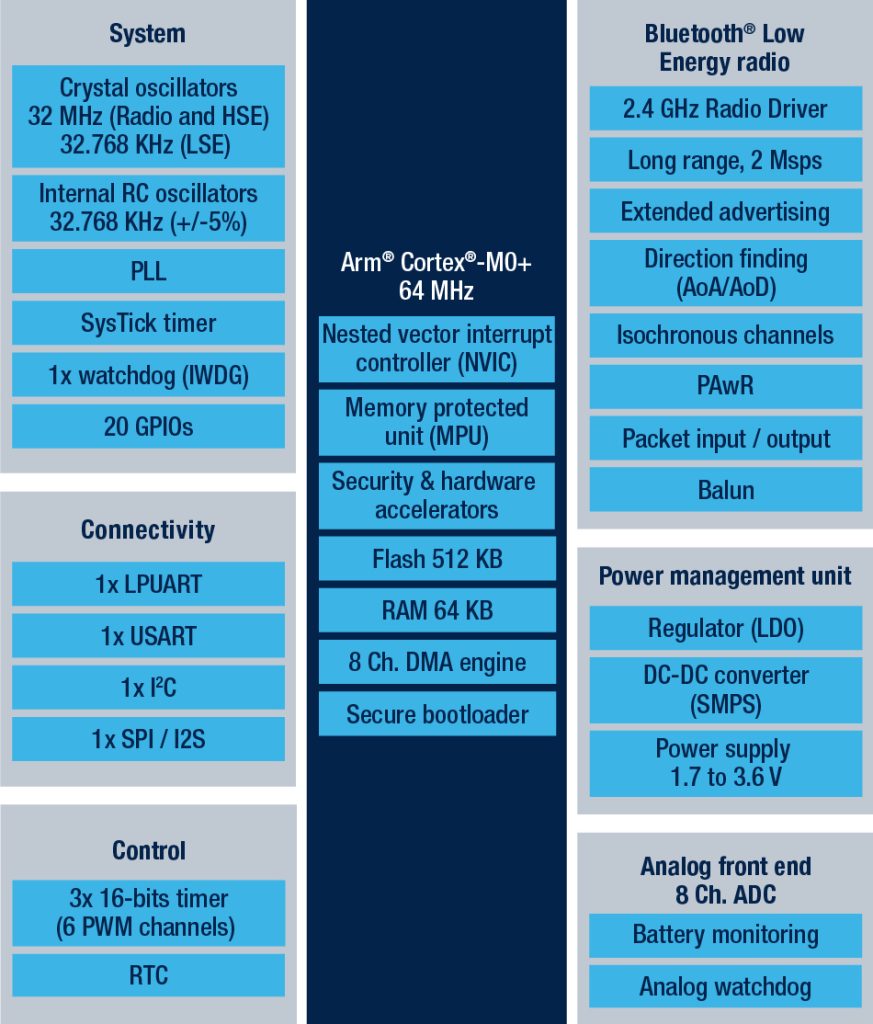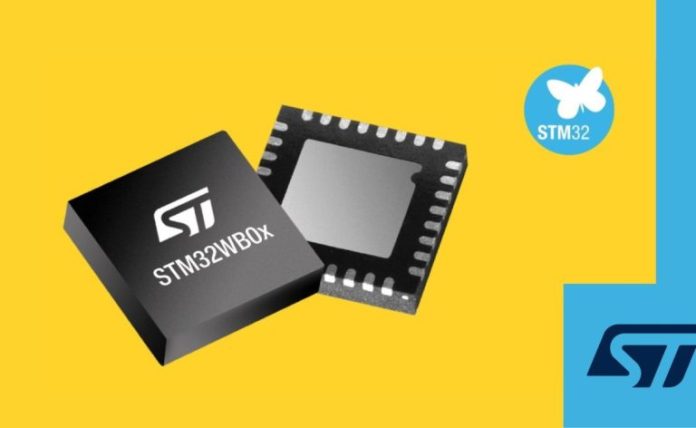Author: STMicroelectronics
ST is launching the STM32WB05 and the STM32WB06/07, thus extending the STM32WB0 series inaugurated late last year with the introduction of the STM32WB09. The new family fully realizes the transition from BlueNRG-LP(S) devices to enable developers to take advantage of the STM32Cube ecosystem. Moreover, we are announcing the STM32WB05xN, our new network processor for Bluetooth LE applications, enabling a significantly lower bill of material and a more straightforward implementation for integrators wishing to use a simple radio link with a serial interface. Therefore, today’s announcement is highly symbolic as we promised to deliver the STM32WB0 series by about the first half of 2024 and are glad to meet this target.
STM32WB09, STM32WB06/07, STM32WB05, and STM32WB05xN: What is happening?
The BlueNRG-LP(S) DNA

All the STM32WB0s share a lot of their DNA with the BlueNRG-LP(S). They use the same Cortex-M0+ and a similar Bluetooth stack. Aligning with the STM32Cube Ecosystem meant modifying some APIs and processes. However, migrating from the BlueNRG stack to the STM32WB0 remains straightforward. Integrators creating cost-effective and energy-sensitive solutions will thus inherit the BlueNRG modular software stack geared toward memory footprint optimizations and performance. The stack also stands out thanks to its interoperability and maturity. Similarly, developers enjoy the same advertising extensions, 2 Mbps high-speed, and 1.3 km (0.8 miles) unobstructed long-range and new ones, like Periodic Advertising with Response (PAwR), while reusing some of the BlueNRG-LPS PCB reference designs.

In essence, PAwR, is a bidirectional version of periodic advertising, a technology that enables a Bluetooth device to send an advertisement at deterministic intervals. Consequently, a system can stay in deep sleep and know exactly when to wake up to receive an advertisement, thus significantly extending battery life. Periodic advertisement with response builds on this technology by enabling the device receiving the advertisement to respond to the broadcaster. This is crucial for one-to-many topologies like electronic shelf labels (ESL) that need to send information to many systems simultaneously and have the receiving devices acknowledge that they received the message, for instance.
In fact, we will soon share the ESL demo we showcased at the last Embedded World. It uses PAwR on an STM32WB09 to show what an electronic label can do. The application is available on our STM32 Hotspot Github page for download to ensure any developers can reproduce it in their lab or learn from our implementation.
STM32WB05
When digging into the new portfolio, we see that the STM32WB05 is a direct descendant of the BlueNRG-LPS and is certified Bluetooth LE 5.4. Hence, as long it has the necessary hardware elements, it can perform angle of arrival (AoA) or departure (AoD) calculations for position tracking. Both are a favorite in applications like asset tracking, which benefits from the ability to locate items in a very cost-effective and power-efficient manner. AoA and AoD are also popular in large infrastructures, like airports or stadiums, where companies must track assets and the people they host. Like the BlueNRG-LPS, the STM32WB05 comes with 192 KB of flash and 24 KB of RAM.
STM32WB06/07
The STM32WB06/07 takes its DNA from the BlueNRG-LP. As such, just like all the STM32WB0s, it features functionalities like advertising extensions, 1.3 km (0.8 miles) unobstructed long-range, and a high-speed connection while providing 256 KB of flash and 64 KB of RAM. As the BlueNRG-LP(S), it also stands out thanks to its low power consumption (4.3 mA peak current in transmission at 0 dBm) and its ability to support an RX sensitivity of -104 dBm at 125 kbps. It doesn’t offer AoA and AoD because it targets applications that require more memory than the STM32WB05 but don’t perform asset tracking or people monitoring. It thus represents a compromise for teams looking to optimize their bill of materials.
STM32WB09
Integrators looking for more flash and AoA/AoD capabilities will gravitate toward the STM32WB09. Architecturally, the device is a BlueNRG-LPS with 64 KB of RAM instead of 24 KB to allow for more complex applications. It also has an updated radio that supports all Bluetooth LE 5.4 hardware features, like PAwR, and Isochronous Channels, which the other STM32WB0s don’t support. Very simply, Isochronous Channels is a new PHY layer that enables more complex data streams by ensuring the transmission of time-sensitive and synchronized information. In practice, it can carry a segregated audio stream beside the traditional channel, to ensure less current spike in sensitive devices like hearing aids.
The choice to release the STM32WB09 before the others stemmed from a desire to reach partners that are content with the processing capabilities and energy efficiency of the BlueNRG-LP(S) but need the memory afforded by some of the dual-core STM32WBs. For instance, the typical current draw of the device in shutdown mode is only 800 nA or almost half that of an STM32WB55.
STM32WB05xN
The STM32WB05xN takes the value proposition of the STM32WB0 series one step further by offering a network co-processor instead of an application processor. It still features the same +8 dBm output power or a sleep current consumption of 800 nA, but it is much more cost-effective and straightforward to implement. Developers just need a serial interface with the host MCU and send commands over the serial interface to control its Bluetooth radio. Obviously, engineers who need to run an application on their Bluetooth device will choose the other wireless MCUs in our portfolio.
However, those wishing for a drop-in solution for their BLE stack, now have an option that supports the STM32Cube Ecosystem. A common example is a company which already uses a Zephyr stack, although it will work with other software as well. By offering a secondary library that interfaces with the host controller interface instead of the host stack itself, ST ensures that the STM32WB05xN will work in existing projects and be vastly simpler to implement.
To make the adoption of the STM32WB05xN even more accessible, we are releasing the X-NUCLEO-WB05KN1 development board and making the X-CUBE-WB05N package available for download. Put simply, any developer, regardless of expertise, can grab an STM32U5 evaluation kit and compile our example code to run a proof-of-concept showcasing the STM32WB05xN. Developers can then send commands to show the network co-processor in action.
The STM32Cube ecosystem promised land
The initiative behind the STM32WB0 series partly stems from customers requesting to use the STM32Cube ecosystem with their BlueNRG devices. Hence, all STM32WB0s will enjoy the support of tools like STM32CubeMX and STM32CubeIDE that help with the initialization process, project generation, and code development. We are also working on updating STM32CubeProgrammer to debug and flash the device and STM32CubeMonitor-RF to test and optimize RF performances. Consequently, in time, moving from an STM32WBx to an STM32WB0, or vice versa, will be as simple as changing settings in STM32CubeMX, configuring a different pin-out, and adapting to a few different APIs. We’ve also started working on migration guides. The STM32 community is thus gaining in portability and flexibility.
Over time, ST will also bring some features and application demos from the BlueNRG Ecosystem to the STM32Cube Ecosystem. Customers have shared that some of those tools have helped them optimize their workflow, and we want to ensure that the transition doesn’t rob them of the solutions they’ve been relying on. Put simply, we are creating a unified portfolio to ensure developers can move up and down the price-per-performance ladder more fluidly, making this announcement a pivotal moment for our community.
Why is this happening?
The success of the STM32WB
The announcement of the first STM32WB in 2018 was so significant that it disrupted high-end Bluetooth applications. For the first time, the radio and the Cortex-M0+ core driving the wireless stack sat right next to a Cortex-M4, thus allowing developers to create vastly more powerful applications without blowing up their bill of materials. For instance, the Jammy E guitar-shaped MIDI controller wouldn’t have been possible without the STM32WB running the Bluetooth MIDI profile. In fact, the idea of an all-in-one solution became so appealing that we released the STM32WB5MMG soon after. The module houses an STM32WB55, the antenna, baluns, and crystals, further facilitating the creation of robust Bluetooth systems.
Making cost-effective Bluetooth applications accessible to all
In early 2023, we released the STM32WBA, the first wireless Cortex-M33, thus showing our desire to provide powerful and secure systems since the STM32WBA opened the door to a SESIP Level 3 certification. However, teams that didn’t need all this computational power significantly favored BlueNRG. Today, ST updates its portfolio to release devices that can significantly lower a bill of materials without compromising features such as the +8 dBm output power, making them one of the best price-per-feature ratios in the industry. The STM32WB0 series is a testament to the success of the BlueNRGs and the STM32WBs as it harmonizes our portfolio while keeping our extensive price umbrella.
The fact that the STM32WB0s also showcases a Bluetooth LE 5.4-certified radio means that engineers enjoy features like Isochronous Channels. This new PHY layer enables more complex data streams by ensuring the transmission of time-sensitive and synchronized information. However, more than adding to a list of specifications, the Bluetooth LE 5.4 radio is symbolic because it shows that besides being cost-effective, like the BlueNRG-LP(S), the STM32WB0s are also cost-competitive, like the STM32WBs. Hence, more than a rebranding, the STM32WB05xN, STM32WB05, STM32WB06/07, and STM32WB09 represent a new beginning for engineers working on Bluetooth LE applications that want to make their products vastly more accessible.









